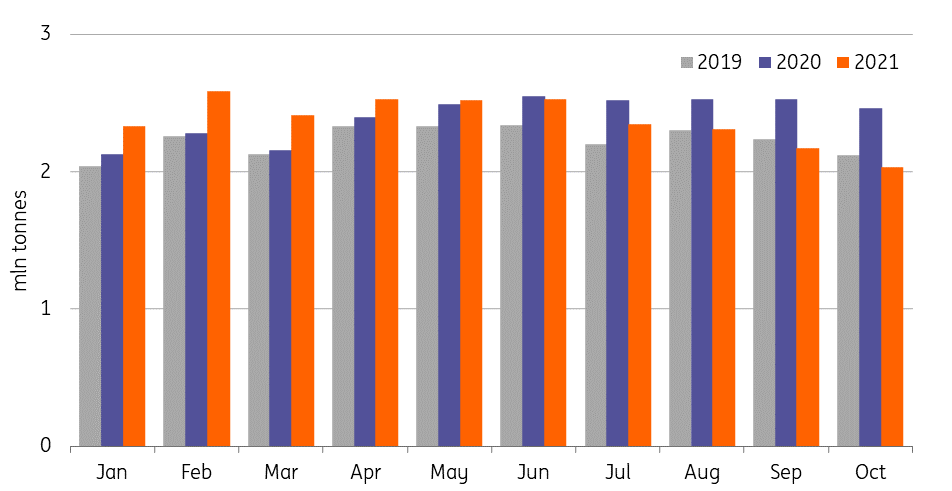Iron ore market to continue rebalancing
Iron ore demand has bone the brunt of deep cuts in the Chinese steel sector. However, with supply continuing to improve, the seaborne iron ore market is set to continue to rebalance itself over the medium term
A year of two halves in the iron ore market
It’s been a year of two halves for the iron ore market. The first half was red hot, the second bitterly cold. In May, prices soared to an all-time high of US$233/tonne and remained elevated thereafter before plunging into a bear market around the end of July. Prices more than halved towards November.
Supply improvement continues despite some supply chain issues
The supply in the seaborne market continues improving, broadly in line with expectations. This is largely due to Brazil, where Vale has been able to see some production growth this year. However, the weak market of low-quality ores prompted Vale to trim the upper bound of its full-year guidance range by 15Mt to the latest range of 315-320Mt for 2021 and issued a lower projection for 2022 to 320-335Mt. Nevertheless, Brazil still contributes to the main incremental supply additions this year, and it's expected to be the key driver to seaborne market growth in the medium term. Shipments from the world's largest seaborne exporter, Australia, struggled during 2Q21 and most of 3Q21 due to weather-related disruptions and extended maintenance works. Still, there are signs that exports have improved during the final quarter of 2021, a trend that is expected to continue through next year.
The supply of non-traditional iron ore fell this year as market conditions changed. A strong rebound in India’s steel sector led to higher demand for its own iron ore. Export demand for India’s low-grade fines fell sharply faced with high freight costs and steep discounts of lower-grade ores from the main consumer, China. Skyrocketing coking coal prices in China have put strong pressure on certain quality types such as lump and low-grade fines, as steelmakers diverge away from these relatively higher fuel rate products. As such, demand for high-grade fines and pellets remains elevated, which is also because of the pressure of production cuts on Chinese steel. As a result, stronger high-grade fines and pellet prices have prompted a supply response. It is expected that the supply of these products will see an improvement in the medium term.
Consumption plunges amid China's aggressive steel cuts
Demand developments have prompted extraordinary market volatility. A downward spiral kicked off with a slew of strong policy enforcements on steel production cuts, as the whole sector in China is very momentum-driven. Iron ore demand fell sharply with mills from multiple regions required to cut production to fulfil the mandate on flat growth in line with the state’s decarbonisation goals and extended curbs in the top production hub of Tangshan city for ‘Olympic Blue’. In 2H21, various steel cuts in China are estimated to lead to around 50Mt losses in crude steel and further result in a fall of hot metal production. Hence, during the period, iron ore consumption fell sharply by around 35Mt. The aggressive steel cuts in 2H21 and weaker iron ore consumption have led to growing inventories of imported ore at Chinese ports. Overall, Chinese iron ore imports are estimated to fall by by more than 3% YoY in 2021.
Lower steel production has failed to lift steel mill margins which had turned negative in 4Q21 due to weaker demand from the downstream property sector and slower activity from others due to frequent power shortages. More importantly, the weakening China property sector and construction new-starts have come under significant pressure, with major property developers struggling in the government-led deleveraging campaign.
Daily hot metal production in China

China's policy continues to play a key role
The Chinese property sector has clearly been a major concern amid the debt crisis out of some property developers. However, our economists think activity here is not all doom and gloom as property investment growth is still 1.1 percentage points faster than headline fixed-asset investment (FAI) growth; there will also be a focus on those pipeline projects to bring them to completion.
At the end of 2021, a number of fine-tuning measures targeting the sector combined with credit easing sparked optimism about China's policy becoming more supportive. Iron ore prices started to rise together with steel prices, pre-emptively riding the China property curve and expectations of a round of easing. This was followed by an official announcement from the PBoC on a RRR cut on 6 December, a move that is expected to support fixed-asset investment in infrastructure, transportation and telecommunications and spur economic growth. So the 'stability priority' will provide some support to demand but it doesn't mean we're returning to the old regime where property was turbo-charged. Policies will be fine-tuned to avoid systemic contagion but we don't expect a significant reversal in the Chinese property sector.
Average prices to decline from 2021 levels
The China policy landscape at the macro-level, including moves towards decarbonisation, remains a cap over the medium-term demand outlook for iron ore. As such, China’s steel production is unlikely to return to the 1H21 level. Nevertheless, we expect the seaborn market to remain in deficit through 2023. In addition, the fine-tuning supportive measures in the short term should act to cushion the markets. On average, we expect prices to slide to US$100/t over 2022, with the main upside risks still being potential supply chain disruptions in light of the Omicron variant.

This publication has been prepared by ING solely for information purposes irrespective of a particular user's means, financial situation or investment objectives. The information does not constitute investment recommendation, and nor is it investment, legal or tax advice or an offer or solicitation to purchase or sell any financial instrument. Read more
Download
Download article
10 December 2021
ING commodities outlook 2022: Keeping the faith This bundle contains 11 Articles